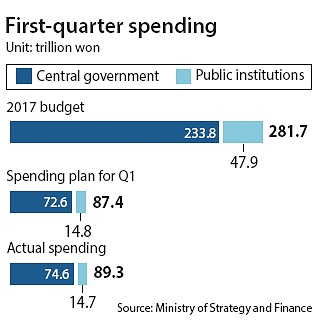Gov’t spending to revive economy outpaces expectations

The government spent 89.3 trillion won ($78.8 billion) in the first three months of the year, which is 1.8 trillion won, or 2 percent, more than the 87.4 trillion won that was previously planned, the Ministry of Strategy and Finance said Thursday. The first-quarter budget accounted for 31.7 percent of the total allocated for this year, which amounted to 281.7 trillion won.
“We will proceed with our plans to execute 58 percent of the total budget in the first half of this year to have the economy recover,” said Park Ho-sung, a director at the Finance Ministry. “We plan to spend more in areas that people can actually feel the effect of economic recovery.”
In December, the government said that it will execute the budget as early as possible in 2017 to preemptively react to various uncertainties both at home and abroad such as weakened domestic consumption and trade issues with the United States and China. The Finance Ministry said it will help boost the economy and stabilize the lives of people financially.
The budget executed by the central government reached 74.6 trillion won in the first quarter, up 1.9 trillion won from 72.6 trillion won that was planned. Another 14.7 trillion won was spent on public institutions.
“The early execution of the budget was possible as the Ministry of Health and Welfare and Ministry of Science, ICT and Future Planning changed their budget schedule and shortened the execution period,” said Park.
The government said that the early execution, in fact, had a positive impact on the domestic economy.
Construction establishment accounts, or the funding given to the construction firms for projects, rose 22.6 percent year on year in February, the Finance Ministry said. In January, it rose 13.4 percent when compared to the previous year.
Composite leading indicators rose from 100.7 in January to 100.9 in February.
Meanwhile, the state-run think tank said there are signs of economic recovery, such as improved investments and exports, but gains are limited due to the weak domestic consumption along with manufacturing operation rates that remain low.
Exports in March rose 13.7 percent year on year and facilities investment jumped 19.5 percent in February when compared to the previous year, according to the Korea Development Institute. However, retail sales only rose 0.5 percent year on year due to the weakened services sector. Manufacturing operation rate remained low at 70.9 percent, and the KDI said it implies that the pace of economic recovery is not likely to be felt soon throughout the overall manufacturing sector.
BY KIM YOUNG-NAM [kim.youngnam@joongang.co.kr]










with the Korea JoongAng Daily
To write comments, please log in to one of the accounts.
Standards Board Policy (0/250자)